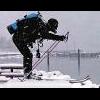<br /><br /><br /><br />hmmm...<br /><br />If I had the o-ring go at any depth, I think I would NOT shut off the air. If I shut off the air, then water would definitely run INSIDE my first stage regulator. Surely, get with my buddy (insta-buddy usually) use his spare second stage and abort the dive. Hopefully the insides of the first stage would be kept dry. <br /><br />What do the "more tec" divers think ?<br /><br />I would like to add this very similar question; what would we do if the burst disk went while at depth?<br />
o-ring face seals are one reason some of us use DIN..., the captured nature of the o-ring is more secure... Take another cue from tech divers, a 5-7' hose on whatever your planning to donate goes a long way to giving people room to address and secure whatever problems your having w/o cramping up on each other...
Keep your eyes on the prize, in the grand scheme of things, a 1st stage overhaul is nothing,...





















